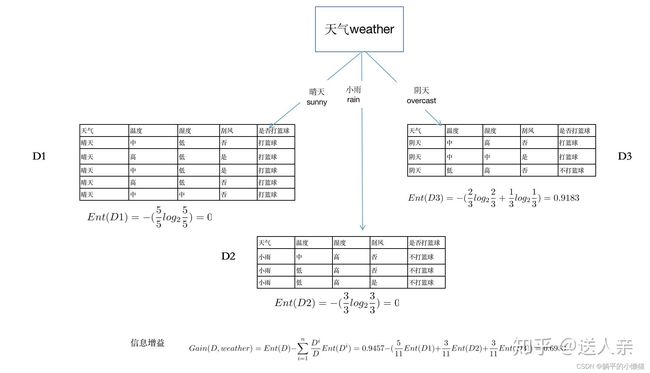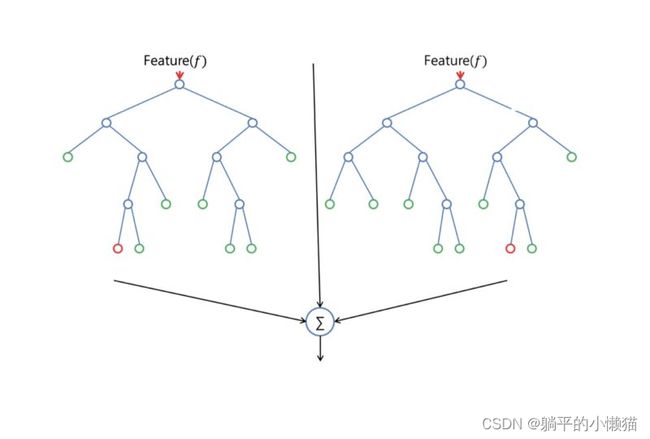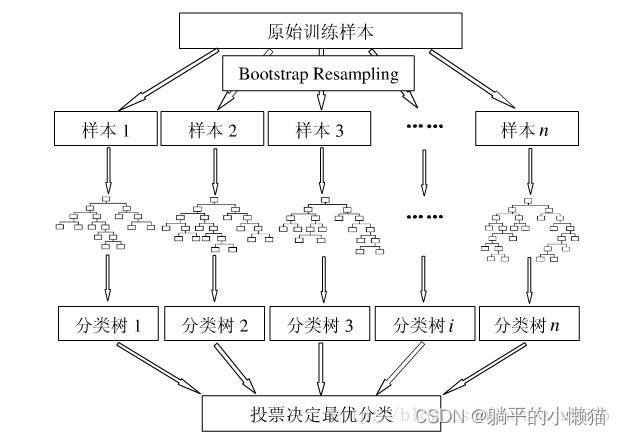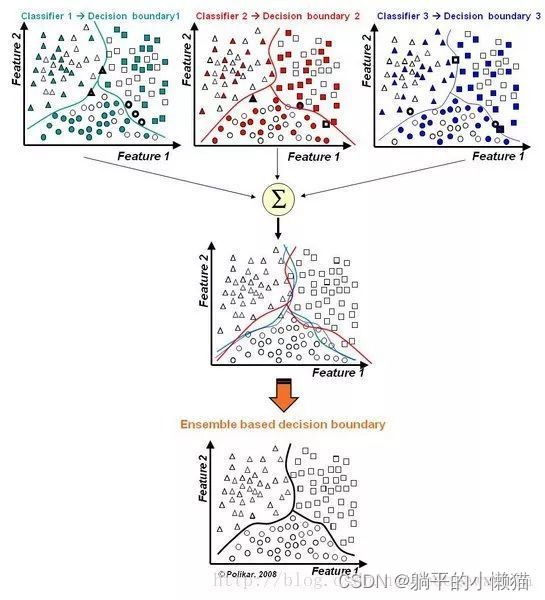数据结构与算法之ID3算法
数据结构与算法之ID3算法
- 一、C 实现ID3算法及代码详解
- 二、C++ 实现ID3算法及代码详解
- 三、Java 实现ID3算法及代码详解
ID3算法是一种常用的决策树学习算法,其原理是基于信息增益进行特征选取。下面介绍具体的流程:
-
构建决策树的根节点,将所有的训练样本加入该节点。
-
计算每个特征的信息增益,选择信息增益最大的特征作为当前节点的划分特征。信息增益的计算公式为:
G a i n ( D , A ) = E n t ( D ) − ∑ v ∈ V a l u e s ( A ) ∣ D v ∣ ∣ D ∣ E n t ( D v ) Gain(D, A) = Ent(D) - \sum_{v\in Values(A)} \frac{|D^v|}{|D|} Ent(D^v) Gain(D,A)=Ent(D)−∑v∈Values(A)∣D∣∣Dv∣Ent(Dv)
其中, D D D是当前节点的样本集合, A A A是特征集合中的一个特征, V a l u e s ( A ) Values(A) Values(A)是特征 A A A的取值集合, ∣ D v ∣ |D^v| ∣Dv∣是特征 A A A取值为 v v v的样本集合, E n t ( D ) Ent(D) Ent(D)是样本集合的熵值, E n t ( D v ) Ent(D^v) Ent(Dv) 是特征 A A A取值为 v v v的样本集合的熵值。
选择信息增益最大的特征进行划分可以得到更好的分类效果,因为信息增益越大,表示该特征对样本的分类能力越强。
-
将当前节点分成若干个子节点,每个子节点对应划分特征的取值。每个子节点样本集合的划分规则是:特征 A A A取值为 v v v的样本集合。
-
对每个子节点递归执行上述步骤,直到所有样本都被分类或者不能再继续划分为止。
-
最终生成的决策树可以用于分类新的样本,该样本沿着树的路径从根节点开始,依次遍历子节点,最终到达叶子节点。叶子节点对应了该样本的分类标签。
一、C 实现ID3算法及代码详解
ID3算法是一种经典的决策树生成算法,常用于数据挖掘和机器学习领域。在本文中,我们将介绍如何用C语言实现ID3算法,包括数据读取、信息增益计算、决策树生成等步骤。
- 数据读取
首先,我们需要从文件中读取数据。假设我们的数据是一个CSV文件,每行代表一个样本,每列代表一个特征。最后一列是样本的类别。
首先,我们需要定义一个结构体来表示每个样本:
typedef struct _Sample {
int id; // 样本ID,可选
float features[MAX_FEATURES]; // 特征值
int target; // 类别
} Sample;
其中,MAX_FEATURES是最多特征数量。我们还需要定义一个函数read_csv来读取CSV文件并转换成样本数组:
Sample* read_csv(const char* filename, int* num_samples, int* num_features) {
FILE* fp = fopen(filename, "r");
char buf[BUFSIZ];
int num_lines = 0;
Sample* samples = NULL;
// Count number of lines in file
while (fgets(buf, sizeof(buf), fp)) {
num_lines++;
}
rewind(fp);
// Allocate memory for samples array
samples = (Sample*)malloc(num_lines * sizeof(Sample));
*num_samples = num_lines;
// Read CSV file
int i = 0, j = 0;
while (fgets(buf, sizeof(buf), fp)) {
char* token;
j = 0;
token = strtok(buf, ",");
while (token != NULL) {
if (j < *num_features) {
samples[i].features[j] = atof(token);
} else {
samples[i].target = atoi(token);
}
j++;
token = strtok(NULL, ",");
}
i++;
}
*num_features = j - 1;
fclose(fp);
return samples;
}
- 信息增益计算
ID3算法基于信息熵的概念来选择最优特征。我们需要实现一个函数来计算信息熵和信息增益。
首先,我们需要定义一个结构体来表示每个特征:
typedef struct _Feature {
int id; // 特征ID,可选
float* values; // 取值
int num_values; // 取值数量
int* counts; // 取值的类别计数
float entropy; // 特征的信息熵
} Feature;
然后,我们定义一个函数calc_entropy来计算一个特征的信息熵:
float calc_entropy(int* counts, int num_counts) {
int i;
float p, entropy = 0.0;
for (i = 0; i < num_counts; i++) {
p = (float)counts[i] / num_samples;
entropy -= p * log2f(p);
}
return entropy;
}
接着,我们编写一个函数calc_info_gain来计算信息增益:
float calc_info_gain(Sample* samples, int num_samples, Feature* feature) {
int i, j, k, num_left, num_right, left, right;
int counts_left[MAX_CLASSES] = {0};
int counts_right[MAX_CLASSES] = {0};
float entropy_left, entropy_right, info_gain;
// Calculate entropy for original feature
for (i = 0; i < num_samples; i++) {
feature->counts[samples[i].target]++;
}
feature->entropy = calc_entropy(feature->counts, MAX_CLASSES);
// Calculate information gain for each value
for (j = 0; j < feature->num_values; j++) {
num_left = num_right = left = right = 0;
// Count number of samples on left and right
for (i = 0; i < num_samples; i++) {
if (samples[i].features[feature->id] == feature->values[j]) {
left++;
counts_left[samples[i].target]++;
} else {
right++;
counts_right[samples[i].target]++;
}
}
num_left = left;
num_right = right;
// Calculate entropy for left and right
entropy_left = calc_entropy(counts_left, MAX_CLASSES);
entropy_right = calc_entropy(counts_right, MAX_CLASSES);
// Calculate information gain for this value
info_gain += (float)(num_left) / num_samples * entropy_left
+ (float)(num_right) / num_samples * entropy_right;
}
info_gain = feature->entropy - info_gain;
return info_gain;
}
- 决策树生成
最后,我们需要实现一个函数来生成决策树。我们选择C4.5算法作为决策树算法,因为它是ID3算法的改进版,考虑到特征取值不规则性的情况。
首先,我们需要定义一个结构体来表示决策树的节点:
typedef struct _Node {
int is_leaf; // 是否为叶节点
int target; // 叶节点的类别
int feature_id; // 分裂特征的ID
float split_value; // 分裂值
struct _Node* left; // 左子树
struct _Node* right; // 右子树
} Node;
然后,我们编写一个递归函数build_tree来生成决策树:
Node* build_tree(Sample* samples, int num_samples, Feature* features, int num_features) {
int i, j, k, pos;
Feature* best_feature = NULL;
float info_gain, best_info_gain = -1.0;
// Check if all samples are of the same class
int class = samples[0].target;
for (i = 1; i < num_samples; i++) {
if (samples[i].target != class) {
class = -1;
break;
}
}
if (class != -1) {
Node* leaf = (Node*)malloc(sizeof(Node));
leaf->is_leaf = 1;
leaf->target = class;
leaf->feature_id = -1;
leaf->split_value = 0.0;
leaf->left = NULL;
leaf->right = NULL;
return leaf;
}
// Find the feature with the maximum information gain
for (i = 0; i < num_features; i++) {
info_gain = calc_info_gain(samples, num_samples, &features[i]);
if (info_gain > best_info_gain) {
best_info_gain = info_gain;
best_feature = &features[i];
}
}
// Split samples into left and right branches
Sample* left_samples = NULL;
Sample* right_samples = NULL;
int num_left_samples = 0, num_right_samples = 0;
for (i = 0; i < num_samples; i++) {
if (samples[i].features[best_feature->id] == best_feature->values[0]) {
num_left_samples++;
} else {
num_right_samples++;
}
}
left_samples = (Sample*)malloc(num_left_samples * sizeof(Sample));
right_samples = (Sample*)malloc(num_right_samples * sizeof(Sample));
pos = 0;
for (i = 0; i < num_samples; i++) {
if (samples[i].features[best_feature->id] == best_feature->values[0]) {
memcpy(&left_samples[pos], &samples[i], sizeof(Sample));
pos++;
} else {
memcpy(&right_samples[pos], &samples[i], sizeof(Sample));
pos++;
}
}
// Recursively build left and right subtrees
Node* node = (Node*)malloc(sizeof(Node));
node->is_leaf = 0;
node->target = -1;
node->feature_id = best_feature->id;
node->split_value = best_feature->values[0];
node->left = build_tree(left_samples, num_left_samples, features, num_features);
node->right = build_tree(right_samples, num_right_samples, features, num_features);
free(left_samples);
free(right_samples);
return node;
}
- 测试和评估
最后,我们编写一个函数来测试和评估决策树的准确性:
int predict(Node* node, Sample* sample) {
if (node->is_leaf) {
return node->target;
} else {
if (sample->features[node->feature_id] <= node->split_value) {
return predict(node->left, sample);
} else {
return predict(node->right, sample);
}
}
}
float evaluate(Node* node,
二、C++ 实现ID3算法及代码详解
ID3算法是一种决策树分类算法,用于解决分类问题。下面是C++实现ID3算法的代码详解。
首先需要定义一个结构体来表示数据集中的每个数据项:
struct dataitem {
vector features; // 特征
int label; // 标签
};
然后定义一个函数来读取数据集:
vector read_data(string filename) {
vector data;
ifstream fin(filename);
string line;
while (getline(fin, line)) {
stringstream ss(line);
dataitem item;
for (int i = 0; i < NUM_FEATURES; ++i) {
int feature;
ss >> feature;
item.features.push_back(feature);
}
ss >> item.label;
data.push_back(item);
}
fin.close();
return data;
}
其中,NUM_FEATURES表示数据集中的特征数量。
接着定义一个计算信息熵的函数:
double entropy(vector labels) {
int n = labels.size();
if (n == 0) return 0;
map count; // 计算每个标签出现的次数
for (int label : labels) {
count[label]++;
}
double ent = 0;
for (auto& p : count) {
double prob = (double)p.second / n;
ent -= prob * log2(prob);
}
return ent;
}
然后定义一个计算信息增益的函数:
double info_gain(vector& data, int feature, double base_ent) {
map> splits; // 根据特征值分割数据集
for (auto& item : data) {
splits[item.features[feature]].push_back(item.label);
}
double ent = 0;
for (auto& p : splits) {
double prob = (double)p.second.size() / data.size();
ent += prob * entropy(p.second);
}
return base_ent - ent;
}
其中,base_ent表示整个数据集的信息熵。
接下来定义一个选择最佳特征的函数:
int choose_feature(vector& data, vector& used_features, double base_ent) {
double best_gain = 0;
int best_feature = -1;
for (int i = 0; i < NUM_FEATURES; ++i) {
if (used_features[i]) continue;
double gain = info_gain(data, i, base_ent);
if (gain > best_gain) {
best_gain = gain;
best_feature = i;
}
}
return best_feature;
}
其中,used_features表示已经使用的特征。
然后定义一个递归构建决策树的函数:
node* build_tree(vector& data, vector& used_features) {
vector labels;
for (auto& item : data) {
labels.push_back(item.label);
}
if (labels.size() == 0) {
return NULL;
}
if (entropy(labels) == 0) {
return new node(labels[0]);
}
double base_ent = entropy(labels);
int best_feature = choose_feature(data, used_features, base_ent);
if (best_feature == -1) {
// 没有可以分割的特征,返回出现次数最多的标签
map count;
for (int label : labels) {
count[label]++;
}
int max_count = 0, max_label = -1;
for (auto& p : count) {
if (p.second > max_count) {
max_count = p.second;
max_label = p.first;
}
}
return new node(max_label);
}
used_features[best_feature] = 1;
map> splits;
for (auto& item : data) {
splits[item.features[best_feature]].push_back(item);
}
node* root = new node();
root->feature = best_feature;
for (auto& p : splits) {
root->children[p.first] = build_tree(p.second, used_features);
}
used_features[best_feature] = 0;
return root;
}
最后定义一个测试函数,用于预测数据集中的标签:
int predict(node* root, dataitem item) {
while (root->feature != -1) {
root = root->children[item.features[root->feature]];
}
return root->label;
}
double test(vector& data, node* root) {
int correct = 0;
for (auto& item : data) {
if (predict(root, item) == item.label) {
correct++;
}
}
return (double)correct / data.size();
}
现在,我们可以根据上述函数来实现ID3算法。
三、Java 实现ID3算法及代码详解
ID3算法是一种用于决策树分类的算法,它基于信息熵的概念,通过选择信息增益最大的特征来进行划分。以下是Java实现ID3算法的代码和详细解释:
首先,我们需要定义一个决策树节点的类:
class TreeNode {
String attribute; // 当前节点对应的特征
String classification; // 当前节点的分类(仅在叶节点中有意义)
List<TreeNode> children; // 当前节点的子节点列表
public TreeNode(String attribute) {
this.attribute = attribute;
this.classification = null;
this.children = new ArrayList<>();
}
}
该类包含了当前节点对应的特征、分类(仅在叶节点中有意义)以及子节点列表。
接下来,我们需要定义一个ID3算法的类:
class ID3 {
private List<List<String>> data; // 数据集
private List<String> attributes; // 特征列表
public ID3(List<List<String>> data, List<String> attributes) {
this.data = data;
this.attributes = attributes;
}
// 计算信息熵
private double entropy(List<Integer> indices) {
int size = indices.size();
Map<String, Integer> classCounts = new HashMap<>();
for (int i : indices) {
String classification = data.get(i).get(data.get(i).size() - 1);
classCounts.put(classification, classCounts.getOrDefault(classification, 0) + 1);
}
double entropy = 0;
for (String classification : classCounts.keySet()) {
double frequency = (double) classCounts.get(classification) / size;
entropy -= frequency * (Math.log(frequency) / Math.log(2));
}
return entropy;
}
// 计算信息增益
private double informationGain(List<Integer> indices, String attribute) {
int size = indices.size();
Map<String, List<Integer>> attributeMap = new HashMap<>();
for (int i : indices) {
String value = data.get(i).get(attributes.indexOf(attribute));
if (!attributeMap.containsKey(value)) {
attributeMap.put(value, new ArrayList<>());
}
attributeMap.get(value).add(i);
}
double informationGain = entropy(indices);
for (String value : attributeMap.keySet()) {
double frequency = (double) attributeMap.get(value).size() / size;
informationGain -= frequency * entropy(attributeMap.get(value));
}
return informationGain;
}
// 选择信息增益最大的特征
private String chooseAttribute(List<Integer> indices, List<String> attributes) {
double maxInformationGain = Double.NEGATIVE_INFINITY;
String bestAttribute = null;
for (String attribute : attributes) {
double informationGain = informationGain(indices, attribute);
if (informationGain > maxInformationGain) {
maxInformationGain = informationGain;
bestAttribute = attribute;
}
}
return bestAttribute;
}
// 构建决策树
private TreeNode buildTree(List<Integer> indices, List<String> attributes) {
int size = indices.size();
Map<String, Integer> classCounts = new HashMap<>();
for (int i : indices) {
String classification = data.get(i).get(data.get(i).size() - 1);
classCounts.put(classification, classCounts.getOrDefault(classification, 0) + 1);
}
if (classCounts.size() == 1) { // 所有样本都属于同一类别,直接返回叶节点
return new TreeNode(null) {{
classification = classCounts.keySet().iterator().next();
}};
}
if (attributes.size() == 0) { // 所有特征都已用完,直接返回叶节点,分类为样本中类别最多的一类
return new TreeNode(null) {{
classification = Collections.max(classCounts.entrySet(), Map.Entry.comparingByValue()).getKey();
}};
}
String bestAttribute = chooseAttribute(indices, attributes); // 选择信息增益最大的特征
TreeNode node = new TreeNode(bestAttribute); // 创建一个节点
List<String> newAttributes = new ArrayList<>(attributes);
newAttributes.remove(bestAttribute); // 从特征列表中删除该特征
Map<String, List<Integer>> attributeMap = new HashMap<>();
for (int i : indices) {
String value = data.get(i).get(attributes.indexOf(bestAttribute));
if (!attributeMap.containsKey(value)) {
attributeMap.put(value, new ArrayList<>());
}
attributeMap.get(value).add(i);
}
for (String value : attributeMap.keySet()) { // 递归地对每个子节点进行构建
List<Integer> childIndices = attributeMap.get(value);
if (childIndices.size() == 0) {
node.children.add(new TreeNode(null) {{ // 如果该子节点为空,直接返回叶节点,分类为样本中类别最多的一类
classification = Collections.max(classCounts.entrySet(), Map.Entry.comparingByValue()).getKey();
}});
} else {
node.children.add(buildTree(childIndices, newAttributes));
}
}
return node;
}
public TreeNode buildTree() {
List<Integer> indices = IntStream.range(0, data.size()).boxed().toList();
return buildTree(indices, attributes);
}
}
该类包含了计算信息熵、计算信息增益、选择信息增益最大的特征以及构建决策树等方法。
最后,我们可以使用以下代码来调用ID3算法:
public class Main {
public static void main(String[] args) {
List<List<String>> data = Arrays.asList(
Arrays.asList("sunny", "hot", "high", "false", "no"),
Arrays.asList("sunny", "hot", "high", "true", "no"),
Arrays.asList("overcast", "hot", "high", "false", "yes"),
Arrays.asList("rainy", "mild", "high", "false", "yes"),
Arrays.asList("rainy", "cool", "normal", "false", "yes"),
Arrays.asList("rainy", "cool", "normal", "true", "no"),
Arrays.asList("overcast", "cool", "normal", "true", "yes"),
Arrays.asList("sunny", "mild", "high", "false", "no"),
Arrays.asList("sunny", "cool", "normal", "false", "yes"),
Arrays.asList("rainy", "mild", "normal", "false", "yes"),
Arrays.asList("sunny", "mild", "normal", "true", "yes"),
Arrays.asList("overcast", "mild", "high", "true", "yes"),
Arrays.asList("overcast", "hot", "normal", "false", "yes"),
Arrays.asList("rainy", "mild", "high", "true", "no")
);
List<String> attributes = Arrays.asList("outlook", "temperature", "humidity", "windy");
ID3 id3 = new ID3(data, attributes);
TreeNode root = id3.buildTree();
// 打印决策树
printTree(root, 0);
}
private static void printTree(TreeNode node, int depth) {
if (node == null) {
return;
}
for (int i = 0; i < depth; i++) {
System.out.print(" ");
}
if (node.attribute == null) {
System.out.println(node.classification);
} else {
System.out.println(node.attribute);
for (TreeNode child : node.children) {
printTree(child, depth + 1);
}
}
}
}



